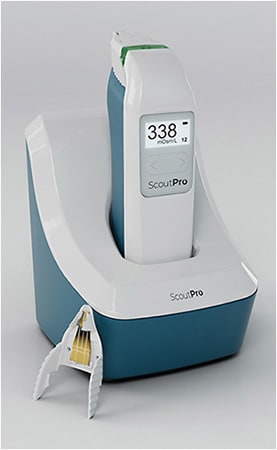Portable device aids in identifying ocular surface risks prior to corneal surgery
In recognizing ocular surface disease’s negative impact on the outcome of cataract and refractive procedures, and the high patient volume in ophthalmic practices, Trukera Medical offers the ScoutPro Osmolarity System.
Here, corneal surgeons familiar with the device discuss its attributes.
Accuracy
The device, comprised of a pen with a keypad and LCD display, charging base, and single-use disposable test card, identifies hyperosmolarity, or too much salt, in the tears, via a specific measurement of a nanoliter volume of tears in 10 seconds, according to the company.
Ivan Mac, MD, medical director and CEO of Metrolina Eye Associates, in Matthews, North Carolina, says the device has excellent sensitivity and specificity for ocular surface risk.
Hyperosmolarity, or too much salt in the tears, can cause light scattering, leading to refractive instability and, thus, incorrect biometry readings. Incorrect biometry readings lead to less-than-optimal visual outcomes for patients undergoing cataract and refractive surgeries.
“[The ScoutPro Osmolarity System] is a tool that is helpful in preoperatively screening cataract surgery patients for ocular surface disease, which can have a negative effect on the patient’s visual outcome,” Dr. Mac explains. “By preoperatively screening, I can identify patients at risk, manage it, and improve postop visual outcomes.”
Christopher E. Starr, MD, associate professor of ophthalmology, director refractive surgery, and director ophthalmic education for Weill Cornell Medicine and New York-Presbyterian Hospital, adds that his patients appreciate the objective data available from the device, as the data motivate patients to remain compliant with their prescribed pre- and postsurgical management plans.
Dagny Zhu, MD, cornea, cataract, and refractive surgeon and medical director/partner with NVISION Eye Centers, in Rowland Heights, California, says that since using the ScoutPro Osmolarity System, her “unhappy postop patient rate” has decreased.
“Without an objective test like osmolarity, to assess the ocular surface, I was not properly identifying or screening out potentially poor surgical candidates, especially for premium IOLs, as well as I should have been,” she divulges. “That’s because hyperosmolarity—especially due to abnormal tear film evaporation and instability—can be easily missed via slit lamp exam.”

Convenience
The ScoutPro Osmolarity System is portable, enabling the user to bring the testing directly to patients anywhere in the practice. This streamlines presurgical testing, notes those interviewed. In addition, it is reimbursed by Medicare under the CMS Clinical Lab Fee Schedule and Medicare Advantage plans.
“I added it to my refractive and cataract surgery workups without any impact on clinic flow,” points out Dr. Zhu. “Additionally, I didn’t encounter any staff resistance to it, as it’s so easy to use. Hyperosmolarity provides a quantitative measure of ocular surface disease/dry eye severity in only seconds, and without causing any patient discomfort.”
Dr. Starr agrees that the ScoutPro Osmolarity System is easy to operate.
“Anyone who has already performed osmolarity testing or operated any diagnostic device can pick it up right away,” he says. “Due to the short learning curve, portability, and ease of use, the ScoutPro has increased practice efficiency and has streamlined the technician workflow—a win-win for the practice and our patients.”
A Suggestion
Dr. Zhu recommends other corneal surgeons incorporate the ScoutPro Osmolarity System as part of their new patient evaluation and standard preoperative work ups.
“You’ll be surprised at how much ocular surface risk you were missing before and how much better you’ll be able to serve your patients’ needs to improve their postop visual outcomes,” she says. “A happy patient is a happy surgeon!” CP














